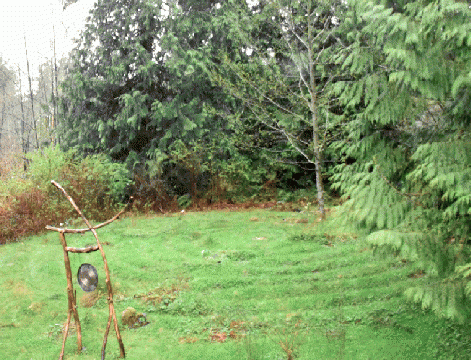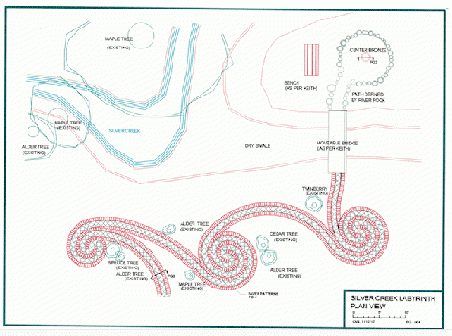The path was much enjoyed during the 2006 summer solstice. A few days later, when some rain started to wash away the flour, I decided to make the labyrinth permanent. There was a inconvenient pile of tailings from when a septic tank was buried that needed to be moved. After hauling and spreading thirty full wheelbarrows of dirt, I had the slightly redesigned labyrinth lines mounded. Over the years, raised planters were put in to better define the turnarounds, and a tree grew on one of the border lines. I love the labyrinth.
MAB: I love that you decided to make the temporary flour labyrinth into a permanent one!
CN: Not long after that labyrinth was completed, another friend told her friends about my labyrinth and we arranged to walk the labyrinth one afternoon. That was my intro to Samanth DeSoer, who wanted to build a public labyrinth in nearby Bellingham. I had lots of experience with public art projects and parks in Seattle, so I volunteered to help.
After five years, we had all the permissions and funding for the Fairhaven Labyrinth. I had drawn up a design for that nine circuit labyrinth and we tried it out every solstice and equinox for years, laying it out in marking lime with a field striper borrowed from Bellingham Parks and Recreation. It solidified into a beautiful paver path in a beautiful park. I was able to do the construction drawings to the satisfaction of Bellingham Parks and most of the work was contracted out.
In 2016, a neighbor, Sarai Stevens became involved in the planning and creation of a food forest in the nearby small town of Sedro Woolley.
MAB: What's a food forest?
CN: A food forest is a permaculture garden that produces edibles like fruits, nuts, berries, and herbs. The plants are perennials so, once established, the garden is quite low maintenance.
She wanted a spiritual aspect to the food forest and asked me to design a labyrinth. I came up with a fairly standard triple spiral that felt good to me. The food forest project fell through, but the labyrinth spark still smoldered. Sarai and Keith Witter, one of the administrators of the Alger Community Hall, asked if the labyrinth could fit near the hall. After walking the back area a few times, the shape morphed to a stream side path by the adjacent Silver Creek. The new shape and environment resonated!
I roughed out the new labyrinth for the 2017 fall equinox and it was embraced by all who walked it. The board of the Alger Improvement Club approved the labyrinth and with a lot of community help over a winter of work parties, the new labyrinth was funded and built.
That is the story of how labyrinths found me and how I followed their paths. My experience with parks, art and engineering has all been put to good use. I have found that labyrinth walking is a structured path to meditation and relaxation. In group settings, it is a natural community builder. I am convinced that labyrinths in public areas are put to good use and our neighborhoods and our society benefit from that use.
(Note: You can view every article as one long page if you sign up as an Advocate Member, or higher).











